Abstract
The COVID-19 pandemic has presented substantial challenges to higher education, leading to economic loss and disruptions in STEM courses. This study addresses these issues through the successful implementation of a problem-based learning research project within the Instrumental Chemistry course at Georgia Gwinnett College (GGC). Focused on instrumental chemistry, the project spans various categories, requiring students to propose solutions to real-case scenarios using specific analytical instruments. Despite the shift to a hybrid teaching modality, students exhibited commendable preparation and investigation skills, as demonstrated by their projects. Assessment data, including a student survey and written report evaluations, underscore significant skill improvements in literature survey, instrument selection, experimental design, and data analysis. This problem-based learning approach not only mitigated the disruptions caused by the pandemic but also fostered enhanced capabilities and motivation among students. The study’s findings contribute insights into the adaptability and effectiveness of problem-based learning in analytical chemistry education within a hybrid teaching framework, offering valuable considerations for future educational strategies in STEM disciplines and beyond.
1. Introduction
For the past few years, the COVID-19 pandemic has had a severe impact on higher education, according to the American Council of Education (ACE), resulting in an estimated economic loss of more than USD 120 billion in the U.S. due to the reduction in domestic and international enrollment, loss of research funding, decreased state appropriations, and increased student borrowing [1]. Student surveys indicate a drop in self-reported satisfaction with online learning as a response to COVID-19 [2], and this dissatisfaction was likely confounded by external factors such as the necessity of caring for family members and economic instability.
STEM courses with lab components may pose even greater challenges to online/remote instruction because they include hands-on laboratory experiments and research projects as part of their curricula [3]. Although institutions of higher education responded quickly to the pandemic by replacing face-to-face lectures and laboratory experiments with online learning and virtual laboratory exercises, this rapid transition process created new challenges and obstacles for both instructors and students [4,5,6]. To what extent this pandemic has adversely affected students may be difficult to quantify, and we will probably not be able to understand its full impact until the pandemic ends [7]. The introduction of variable virtual laboratories into STEM education has been a hot topic in recent years, from K-12 to higher education [8,9,10,11].
1.1. Adaptions during COVID at Georgia Gwinnett College
Like many other US universities and colleges, Georgia Gwinnett College (GGC) has also observed a reduction in enrollment, including in STEM courses, as a result of the pandemic. GGC is a public, four-year, open-access institution in the University System of Georgia, located in Gwinnett County, the second most populous and ethnically diverse county in Georgia. During the 2019–2020 academic year, the college had an enrollment of approximately 12,831 students from 32 U.S. states and territories and 120 countries. GGC has been ranked by the U.S. News & World Report for seven consecutive years as one of the most ethnically diverse colleges in the South, and most recently, it was ranked #20 in Top Public Schools and #4 in Most Innovative Schools. GGC is devoted to building a higher education system that combines affordability, innovative teaching practices, and faculty engagement to drive students to success. To accomplish these goals, GGC has a diverse faculty body that reflects the student population, which it believes promotes a conducive intellectual environment. The college was approved to be an eligible institution under Title III [12], an acknowledgment of GGC’s growing population of minority and low-income students, many of whom are self-supported and must balance school, work, and family commitments. The vast majority of GGC students are first-generation college students in their families. In total, approximately two fifths of GGC students (39.1%) have declared majors in the School of Science and Technology (SST), intending to pursue post-graduate degrees or attend professional schools.
All these cited circumstances present challenges to student success. To address this, GGC has been focusing on small lecture and lab classes (capped at 24 students), giving students more face-to-face interactions with instructors and with each other, creating more opportunities for small group and collaborative learning. However, due to COVID-19, the transition from smaller, more interactive classes to isolated distance learning has undoubtedly disrupted student learning and has required faculty to develop new instruction approaches that would allow students to learn hands-on concepts through virtual or hypothetical activities and exercises [13,14].
1.2. Problem-Based Learning an Adaptive Pedagogical Approach
Problem-based learning (PBL) is a widely used instructional method that focuses on students identifying and resolving problems from “real-case” scenarios, usually in small groups or independently, through “self-directed learning” [15]. This approach has been the subject of considerable interest in healthcare, medical, and STEM education [16,17,18,19,20,21,22,23,24]. Although educators recognize that students tend to separate “theoretical knowledge” from “practical knowledge”, PBL helps to fill the gap [25,26]. Although PBL was pioneered in the 60s in the medical field, the majority of the projects and studies enriched the medical and healthcare field. Comparatively, there are relatively limited PBL works published in chemistry education. GGC has a tradition of embedding research experiences in STEM courses as a means of training and equipping our undergraduate students with strong fundamental research skills [27,28]. In this paper, we present a 4000-level course-embedded problem-based learning research project that was developed prior to COVID-19 but remains a viable activity during the pandemic. This activity was introduced to CHEM4100K—Instrumental Chemistry with Laboratories. CHEM4100K is offered at GGC every Fall semester. The student body in this course typically includes junior to senior chemistry and/or biochemistry majors. The purpose of this activity is to provide students with a series of hypothetical questions that mimic real analytical chemistry problems. For each problem, students need to propose one or more experiments to solve the problem, which includes determining the most suitable instrumentation, justification for the selection, sample preparation, methods of analysis, and anticipated results. Student responses are then organized for presentation in a formalized, academic-style written report. Additionally, students are required to give a 10-minute oral presentation at the end of the project. The intent of this exercise is to help students learn how to (i) conduct an independent literature survey related to extractions and qualitative determinations of chemical compounds, (ii) design steps of a chemical analysis, which include problem-solving strategies, sampling, and sample preparation, method development, data analysis, and reporting collected data in an appropriate format, and (iii) practice both oral and written communication skills using appropriate technology.
The research questions investigated in this paper are:
Research question 1: Does the problem-based learning research project enhance students’ proficiency in scientific research and experimental skills?
Research question 2: How do students perceive virtual laboratory experiences in comparison to traditional face-to-face laboratory sessions?
2. Methods
Established in 2006, Georgia Gwinnett College (GGC) is a public, open-access liberal arts institution in Lawrenceville, Gwinnett County in the USA. Notably, GGC is the first four-year college founded in Georgia in over a century and the inaugural four-year public institution established in the United States in the twenty-first century. GGC employs educational strategies such as small class sizes, individualized attention, a diverse and inclusive culture, and comprehensive student mentoring programs to enhance student performance and foster academic success [29]. Following Institutional Review Board (IRB) approval, 11 students were recruited from an Instrumental Chemistry course predominantly composed of chemistry majors.
2.1. Description of Problem-Based Learning Research Projects
In this project, three different categories of problems were given, with two specific topics in each category (see Table 1). Each student selects two topics from different categories on which to work. Each category targets the usage of one specific type of instrument discussed in CHEM4100K, including ICP-MS, HPLC, and GC. These three main types of instruments were targeted because they can address a broad range of analytical problems in chemistry, academia, and industry. Hence, based on the problems selected, students must select the appropriate instrumentation for their research topics. These topics are practical problems, so undergraduate students must perform a literature survey to acquire the background information needed to develop and propose any research method details.

Table 1.
Description of problem-based research projects in three categories.
2.2. Timeline of Problem-Based Research Projects
During the pandemic semester of Fall 2020, this project was introduced and delivered to students in week 2, together with lab report grading rubrics. From week 3–7, students picked and developed initial project ideas based on personal interests. From week 8–13, students worked on the project independently. For Fall 2020, CHEM4100K was delivered in hybrid mode, so all lectures were online, while labs were face-to-face. To meet the requirements for social distancing in the lab space, students were split into two groups and attended labs on alternate weeks so that while Group A worked on a hands-on lab, Group B conducted virtual projects at home, and vice versa. In week 14, the students submitted the final written report and delivered the 10-minute oral presentation.
2.3. Assessment Methods
Two different assessment methods were used for Fall 2020. A brand-new student survey was developed this semester (Supporting Information: Student Survey Questionnaire). Assessment data for the survey was collected anonymously at the end of the activity. The survey was designed to assess student performance and to collect student reflections on the activity as well as their learning experience in a hybrid course. The written reports were graded by the instructor based on a grading rubric (Table 2). This grading rubric has been in use since Fall 2016. Results and comparisons between semesters will be discussed in the following section.

Table 2.
Written report grading rubric.
3. Results
3.1. Examples of Students’ Projects
Examples of student work are included in this section. Overall, students were well-prepared and thoroughly investigated the topic. Please note that only the sample preparation, instrument selection, and method design sections are shown here since these are the most important sections in the activity.
Student project #1: The student is interested in the trace metal content (Cr, Cd, and Pb) in the soil sample with inductively coupled plasma mass spectrometry (ICP-MS) around the abandoned mining town of Auraria, Georgia. “Five soil samples were collected from areas in and around the town for ICP-MS analysis. Samples were taken directly outside the mine (0 miles away, i.e., “ground zero”) and at distances of 0.5, 1, 2.5, and 5 miles from the mine. The five soil samples were digested using concentrated HNO3 (69%, Veritas, redistilled) in a 1:4 volume ratio (2 mL sample to 8 mL of HNO3) using PTFE beakers (Sigma Aldrich, St. Louis, MO, USA). These mixtures were sealed and subsequently heated under gentle reflux (70 °C for 48 h). The digested solutions were then filtered (Whatman GD/X nylon syringe filters, 0.45 µm) and diluted to 50 mL with DI water. Concentrated HNO3 (5 mL) was used as an acid blank for a baseline comparison. A PerkinElmer Elan DRC II ICP-MS (PerkinElmer, Shelton, CT, USA) was used for analysis. Soil digests were introduced into the system using a quartz cyclonic spray chamber and Meinhard nebulizer. Digests were analyzed for Cr-53, Cd-111, Cd-114, and Pb-208 isotopes using peak hopping mode. Signal variability was corrected by running an internal standard (PerkinElmer Environmental Standard Mix 6, PerkinElmer, USA) along with the soil sample digests via a mixing cell. Sc-45 was used as the internal standard for low mass element Cr-53, and In-115 was used as the internal standard for higher mass elements Cd-111, Cd-114, and Pb-208”.
Student project #2: The student is interested in determining the concentration of benzodiazepine in urine samples with HPLC. “An Agilent 1260 HPLC system with an Inertsil C8 analytical column (250 mm × 4 mm, 5 μm) was used to analyze the urine samples and known standards. The mobile phase was composed of ammonium acetate, 0.05 M methanol, and acetonitrile (33:57:10 ratio by volume). All eluent components were HPLC reagent grade and obtained from Sigma Aldrich. Benzodiazepines and related metabolites were quantified at 240 nm using an internal standard of mefenamic acid (6 ng/μL). Thirty urine samples from teenagers were obtained from the public health department for analysis. Urine samples were filtered prior to analysis (Whatman GD/X nylon syringe filters, 0.45 µm) to remove any solid or large impurities and extract benzodiazepine and related metabolites. A total of 1 mL of each filtered sample was transferred to a labeled HPLC vial, and an internal standard of mefenamic acid (6 ng/μL) was added to each vial. A blank and 4 standard solutions with known benzodiazepine concentrations were prepared (0.15, 0.30, 0.45, and 0.60 ng/μL) to construct a standard calibration curve”.
Student project #3: The student is interested in determining ciprofloxacin (antibiotics) in wastewater with HPLC. An Agilent 1260 Infinity II LC System HPLC equipped with a quaternary pump and a diode array detector (DAD) was used. The column consisted of an Eclipse (4.6 × 250 mm) C18, 5 µm analytical column with a flow rate of 1.00 mL/min and a temperature of 35 °C. The detector was set at a wavelength of 280 nm. A total of 20 µL of standard and sample solutions were injected. Pure salts of ciprofloxacin were obtained through Sigma Aldrich. A 1000 ppm stock solution was prepared by dissolving 100 milligrams in 0.1 L of mobile phase. A total of 1% formic acid and acetonitrile in a ratio of 84:16 was combined to create the mobile phase. Once added, the mobile phase was then sonicated at room temperature for 20 min and then filtered with 0.45 µm sterilized cellulose filter paper. The stock solution was stored in amber bottles at 4 °C until used. Five concentrations of each stock were prepared by dilution with concentrations of 10 ppm, 20 ppm, 40 ppm, 60 ppm, and 80 ppm. Each concentration ran through the HPLC machine to determine the calibration curve. A total of 500 mL of wastewater samples were collected in triplets throughout the region in 15 different locations. A total of 200 mL of ethyl acetate was added to each sample and shaken for 30 min at room temperature. Once shaken, the samples were separated through a separation assembly, leaving a lower phase of wastewater and an upper phase of antibiotic liquid. The process was repeated twice to ensure all antibiotics were removed from the wastewater. The upper phase was removed, and 50 mL of ethyl acetate was added to the lower phase to ensure all antibiotics were removed from the wastewater. The mixture was then shaken for 30 min and repeated a second time. The upper layer was then dried in the rotavap at 70 °C until all liquid was evaporated. A total of 2.5 mL of methanol was added to the solid to allow it to run through the HPLC machine. The samples were then injected into the HPLC”.
3.2. Assessment of Student Performance from Survey
The self-assessed improvement of students’ capability in many areas is summarized in Figure 1. Through this project, students reported significant improvement in their capabilities to conduct a literature survey (4.3 out of 5), select proper instrumentation to support analysis (4.7 out of 5), design experiments (4.1 out of 5), prepare standard solutions (4.3 out of 5), perform data analysis (4.4 out of 5), pursue a research topic (4.6 out of 5), and develop laboratory skills (4.3 out of 5). Students reported fair improvement in troubleshooting experiments in the event of unexpected errors (3.8 out of 5). Although this open-ended project targeted many different skills, students perceived it to have an appropriate level of difficulty (2.7 out of 5). Of all the skills reported in Figure 1, the capability of performing a literature survey had little or no correlation (correlation coefficient between −0.1 to 0.1) with the following four skills directly related to performing experiments: (1) selecting instruments, (2) preparing standards, (3) troubleshooting experimental errors, and (4) developing laboratory skills. Strong positive correlation (correlation coefficient > 0.8) was observed for the following three pairs: (1) data analysis and instrumentation selection, (2) data analysis and pursuit of research topics, and (3) laboratory skills and troubleshooting. This indicates that students who developed better laboratory skills through the project were also more likely to gain better skills for troubleshooting experimental errors. Moreover, students who reported greater improvement in data analysis were more likely to report greater improvement in selecting instruments and the ability to pursue research topics.
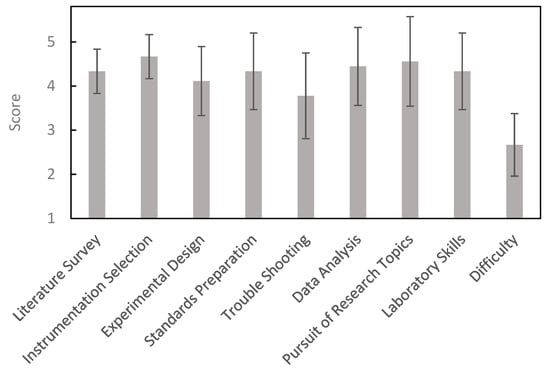
Figure 1.
Students’ self-reported improvement of skills in different areas (n = 9; 1 = deficient, 2 = insufficient, 3 = fair, 4 = good, 5 = excellent). The last column corresponds to students’ perception of the level of difficulty for the project (1 = extremely easy, 2 = somewhat easy, 3 = neither easy nor difficult, 4 = somewhat difficult, 5 = extremely difficult).
3.3. Assessment of Student Performance from Written Report
Students’ performances of written reports were evaluated by instructors, based on data collected over four semesters (Figure 2). Students performed well in almost all the areas except for the Expected Results section. In Fall 2020, courses switched from traditional face-to-face instructional mode to hybrid teaching mode, where a certain percentage of lecture and laboratory activities were online. To investigate the impact of teaching modality on student performance, a one-way analysis of variance (ANOVA) was performed for all areas in the written reports distributed over four semesters. At the significance level of 0.05, there was no significant difference between pre-pandemic semesters (Fall 2016, Fall 2018, and Fall 2019) that involved face-to-face instructional methods and the Fall 2020 semester, where hybrid teaching methods were used during the pandemic. These results indicate that change in teaching modality did not impact student performance or acquisition of skills from this activity.
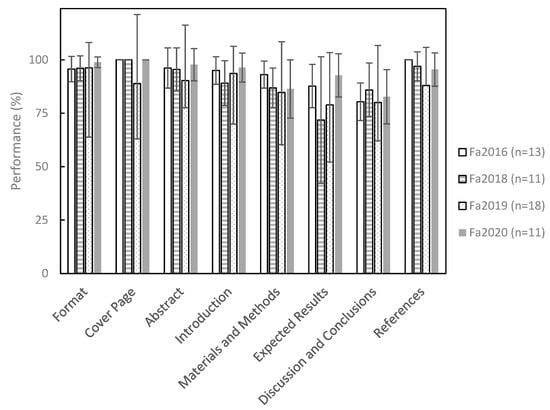
Figure 2.
Student performance of written reports for Fall 2016 (white, n = 13), Fall 2018 (striped, n = 11), Fall 2019 (dotted, n = 18), and Fall 2020 (solid, n = 11) semesters.
3.4. Students’ Perception of the Problem-Based Learning Project
In addition to the self-reported improvement of skills, perception of this activity was also reported (Figure 3). Students agreed that this activity enhanced their experimental skills gained from face-to-face labs (3.9 out of 5) and improved their understanding of theory learned from lectures (3.8 out of 5). In addition, students reported that this activity improved their motivation to learn chemistry (3.8 out of 5). From correlation analysis among all statements, students who reported that this activity enhanced their experimental skills and theoretical understanding were more likely to report improved motivation to learn chemistry from this activity (correlation coefficients > 0.8).
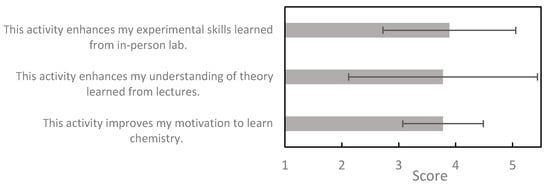
Figure 3.
Students’ perceptions of this lab activity (n = 9; 1 = strongly disagree, 2 = somewhat disagree, 3 = neither agree nor disagree, 4 = somewhat agree, 5 = strongly agree).
In addition to quantitative measures, textual comments from students were used to generate a word cloud (Figure 4). Some of the highlighted comments are:
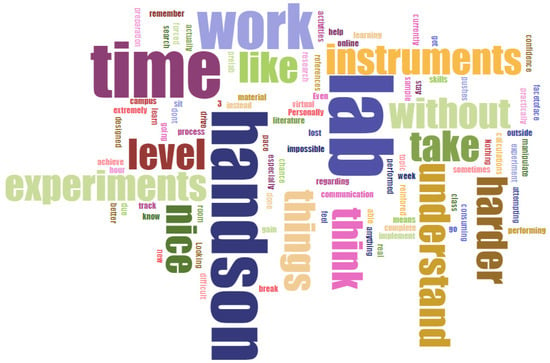
Figure 4.
Word cloud generated from comments of students (n = 9).
- “It forced me to better understand the material and reinforced the things I was learning.”
- “Being able to complete it on your own time and at your own pace is very nice.”
- “I feel like I do not get the hands-on experiment. Even if I know what to do, it is not the same as actually doing it. And that means I do not gain confidence in performing experiments and being in the lab.”
3.5. Student Perspectives of Virtual vs. Traditional Labs
Based on their experience of this activity, students were asked about their perception of virtual labs in general (Figure 5). Students agreed that virtual labs could foster self-regulated learning (3.9 out of 5) and were suitable for presenting learning concepts (3.9 out of 5). Also, students believed that virtual labs could be a good supplement (3.3 out of 5) to face-to-face labs rather than replacements for labs (1.7 out of 5). This is consistent with students’ preference for lab delivery methods (Figure 6), where none of the students preferred all the labs to be entirely virtual. A correlation analysis of all statements revealed that students who agreed that virtual labs fostered self-regulating learning were more likely to agree that virtual labs were suitable for presenting learning concepts, with a correlation coefficient of 0.803 (Appendix A).
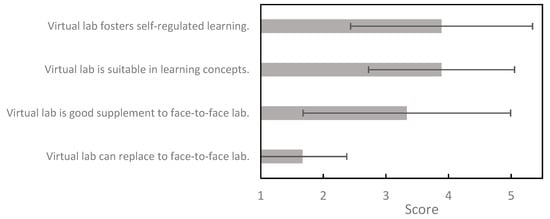
Figure 5.
Students’ perception of virtual lab (n = 9; 1 = strongly disagree, 2 = somewhat disagree, 3 = neither agree nor disagree, 4 = somewhat agree, 5 = strongly agree).
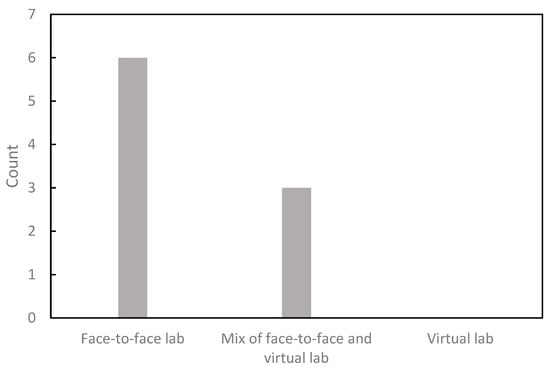
Figure 6.
Students’ preference of lab delivery method (n = 9).
As previously noted, hybrid teaching was adopted in Fall 2020 in response to COVID-19, and so students were asked to compare their perceived experiences between virtual and face-to-face lab activities. Each student selected one skill that they felt had been improved the most by the virtual lab and another skill that they felt was improved the most by the face-to-face lab. As seen in Figure 7, students predominantly reported that the virtual lab was more effective in improving their ability to perform a literature search, while the face-to-face lab was more effective in improving skills in instrument selection, standards preparation, and laboratory skills. Since virtual and face-to-face labs target different skills, a mix of these two is more likely to improve students’ learning in the lab.
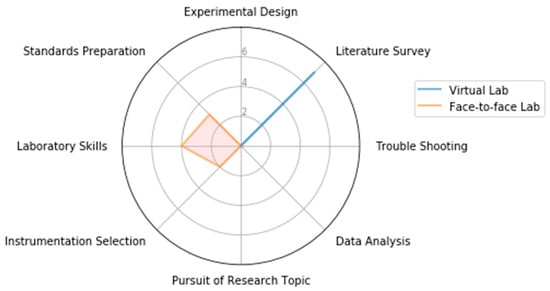
Figure 7.
Radar chart of student-reported effectiveness of virtual labs (blue) and face-to-face labs (orange) for improving different skills (n = 9).
Finally, students were surveyed regarding the delivery method of lecture and virtual lab in a hybrid teaching modality (Figure 8). A mix of synchronous and asynchronous instruction was the method most preferred by students, followed by asynchronous instruction. Synchronous instruction was preferred the least. This can be a valuable data point when instructors decide how to implement lectures and virtual labs in their curriculum.
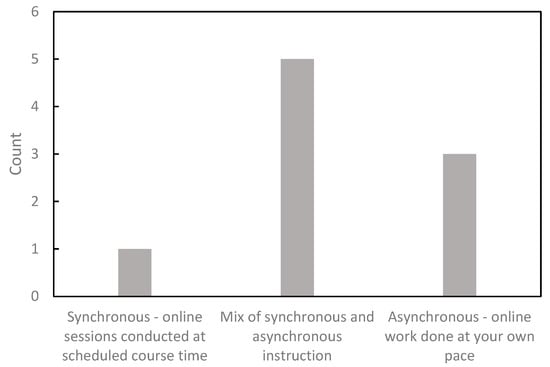
Figure 8.
Students’ preference of delivery method for lecture and virtual lab (n = 9).
4. Discussion
This project has been implemented in Instrumental Chemistry for several semesters so far. Currently, advanced analytical chemistry has integrated multidisciplinary research achievements and is always looking for new frontier research fields. The development in related research disciplines constantly challenges analytical chemistry to evolve and develop improved instruments and methods to address increasingly complex problems [30,31,32]. Both students and instructors in analytical chemistry-related courses will need to adjust to the emerging challenges in the field. This project provided students with a reality-mimicking, problem-based learning environment in analytical chemistry. When students performed the literature survey, they had the opportunity to not only reinforce their theoretical knowledge but also learn new instrumentation and methodology during the investigation of the problems. Since problem-based learning is often a higher level of learning process compared to traditional learning, the ability to acquire and process information is a fundamental skill that every student must possess. Ideally, students will have begun to develop these skills by their junior or senior year, and this project can provide some constructive feedback on their development in this regard.
Several other challenges stem from the change in teaching modality [33]. Due to the social distancing requirement in Fall 2020, the capacity for lab space was reduced to half of the regular capacity. Students were divided into two groups and took turns performing face-to-face labs. Fewer hands-on lab experiences may potentially prevent students from learning some important skills. Our assessment data suggests that students could gain many of those important skills through this entirely virtual problem-based learning project, and their performance was not impacted by the change to hybrid teaching. Despite this, student perceptions indicated that many of them wished for a chance to implement proposed experiments and have a hands-on check of their own theoretical speculations, and this perception should be considered during future planning, along with possible continuing limitations associated with lab activities. Similarly, splitting the students into two lab groups reduced the interaction and collaboration among students, both within the group and between groups. Even though this project focuses on individual student work, the virtual student presentation to the class at the end of the semester does provide a great opportunity for students to learn from each other. This may not entirely mirror the in-person collaboration experience, but the virtual interaction did help to build a sense of community in the course.
In the hybrid course, all lectures and parts of the labs were performed online. One of the biggest concerns for many instructors was determining how to engage students virtually. The instructor played a crucial role in the successful implementation of this problem-based learning project. Clear communication of expectations from students is more likely to maximize students’ learning experience. Providing students with more detailed grading rubrics at the beginning of the project is more likely to keep students on track [34]. The instructor also needed to periodically check with students along the project design, especially for difficult sample preparation and methodology.
Finally, even with the end of the pandemic, hybrid and virtual modalities might still be indispensable methods for delivering higher education. When designing the virtual elements in the course, different instructors may have their own preferences. In Fall 2020, this activity, together with other virtual lab activities, was primarily delivered asynchronously, except for the final presentation. Part of this was because while one group performed face-to-face lab on campus, the other group performed virtual activity at home. This rotational schedule made it impossible for the instructor to supervise both groups simultaneously. Although some instructors believe that synchronous instruction is better, from the student perspective, a mix of synchronous and asynchronous instruction or entirely asynchronous instruction was more favored. This might be something worth considering by instructors when designing future virtual elements in their own courses.
5. Conclusions
This study delves into the multifaceted impact of the COVID-19 pandemic on higher education, particularly scrutinizing the impediments faced by STEM courses with lab components. The research project conducted at Georgia Gwinnett College (GGC), utilizing PBL as an adaptive pedagogical approach, sought to ameliorate these challenges by providing students with a meaningful research experience within the constraints imposed by the pandemic. The outcomes of the study affirm that the PBL research project significantly enhanced students’ proficiency in diverse scientific research and experimental skills. Through surveys, students reported marked improvements in conducting literature surveys, selecting appropriate instrumentation, designing experiments, preparing standard solutions, performing data analysis, pursuing research topics, and developing laboratory skills. Furthermore, the project instigated positive shifts in students’ motivation to learn chemistry, which was evident in their comments and word-cloud responses. The evaluation of student performance, both in written reports and survey responses, indicated a high level of preparedness and thorough investigation of the assigned topics. Notably, the transition to a hybrid teaching modality in response to the pandemic did not adversely affect student performance or their acquisition of skills through this activity.
Building upon the findings of this study, a set of recommendations emerges. First, there is a compelling case for the continued integration of PBL into STEM courses, especially during virtual or hybrid learning. The positive outcomes observed in the PBL research project underscore the potential benefits of enhancing students’ research skills and motivation. Institutions should explore and expand the use of PBL as a pedagogical approach to enrich the learning experience in STEM fields. Another key recommendation involves fostering flexibility in virtual learning environments. Acknowledging the diverse preferences of students for a mix of synchronous and asynchronous instruction, educators should strategically design virtual course elements to cater to various learning styles. Clear communication, detailed grading rubrics, and periodic check-ins are pivotal strategies to augment the virtual learning experience, ensuring that students remain engaged and derive maximum benefit from the educational content. Despite the valuable insights offered by these recommendations, it is imperative to acknowledge the study’s limitations. The small sample size employed in this research limits the generalizability of the findings. To obtain a more comprehensive understanding, future research endeavors should involve larger and more diverse participant groups.
Supplementary Materials
The following supporting information can be downloaded at https://www.mdpi.com/article/10.3390/covid3120120/s1, Student survey questionnaire.
Author Contributions
Conceptualization, X.L., Y.G. and S.M.M.; methodology, X.L.; software, Y.G.; validation, X.L. and Y.G.; formal analysis, X.L., Y.G., S.M.M. and M.K.; investigation, Y.G.; resources, X.L.; data curation, X.L. and Y.G.; writing—original draft preparation, X.L., Y.G., S.M.M. and M.K.; writing—review and editing, X.L.; visualization, Y.G.; supervision, X.L. and Y.G.; project administration, X.L. All authors have read and agreed to the published version of the manuscript.
Funding
This research received no external funding.
Institutional Review Board Statement
Not applicable.
Informed Consent Statement
Not applicable.
Data Availability Statement
The data presented in this study are reported in the article.
Conflicts of Interest
The authors declare no conflict of interest.
Appendix A
Correlation analysis based on statements from Figure 5 (n = 9).
| Virtual Lab Can Replace Face-to-Face Lab. | Virtual Lab Is Good Supplement to Face-to-Face Lab. | Virtual Lab Is Suitable in Learning Concepts. | Virtual Lab Fosters Self-Regulated Learning. | |
| Virtual lab can replace face-to-face lab. | 1.000 | |||
| Virtual lab is good supplement to face-to-face lab. | 0.533 | 1.000 | ||
| Virtual lab is suitable in learning concepts. | 0.404 | 0.603 | 1.000 | |
| Virtual lab fosters self-regulated learning. | 0.324 | 0.588 | 0.803 | 1.000 |
References
- Nietzel, M.T. Pandemic’s Impact on Higher Education Grows Larger; Now Estimated to Exceed $120 Billion. Forbes. 2020. Available online: https://www.forbes.com/sites/michaeltnietzel/2020/09/29/pandemics-impact-on-higher-education-grows-larger-now-estimated-to-exceed-120-billion/?sh=f9ec6e222bdc (accessed on 1 January 2023).
- Means, B.; Neisler, J.; Langer Research Associates. Suddenly Online: A National Survey of Undergraduates during the COVID-19 Pandemic; Digital Promise: San Mateo, CA, USA, 2020. [Google Scholar]
- Villanueva, O.; Derek, B.A.; Morris, J.D.; Simmons, R.; Anfuso, C.; Woodbridge, C.M.; Guo, Y. Adapting to the COVID-19 Online Transition: Reflections in a General Chemistry Sequence Taught by Multiple Instructors with Diverse Pedagogies. J. Chem. Educ. 2020, 97, 2458–2465. [Google Scholar] [CrossRef]
- Anzovino, M.E.; Mallia, A.; Morton, M.S.; Paredes, J.E.B.; Pennington, R.; Pursell, D.P.; Rudd, G.E.A.; Shepler, B.; Villanueva, O.; Lee, S. Insights and Initiatives While Teaching Organic Chemistry I and II with Laboratory Courses in the Time of COVID-19. J. Chem. Educ. 2020, 97, 3240–3245. [Google Scholar] [CrossRef]
- Aristovnik, A.; Keržič, D.; Ravšelj, D.; Tomaževič, N.; Umek, L. Impacts of the COVID-19 pandemic on life of higher education students: A global perspective. Sustainability 2020, 12, 8438. [Google Scholar] [CrossRef]
- Forakis, J.; March, J.; Erdmann, M. The Impact of COVID-19 on the Academic Plans and Career Intentions of Future STEM Professionals. J. Chem. Educ. 2020, 97, 3336–3340. [Google Scholar] [CrossRef]
- Dietrich, N.; Kentheswaran, K.; Ahmadi, A.; Teychené, J.; Bessière, Y.; Alfenore, S.; Laborie, S.; Bastoul, D.; Loubière, K.; Guigui, C.; et al. Attempts, Successes, and Failures of Distance Learning in the Time of COVID-19. J. Chem. Educ. 2020, 97, 2448–2457. [Google Scholar] [CrossRef]
- Ferrell, J.B.; Campbell, J.P.; McCarthy, D.R.; McKay, K.T.; Hensinger, M.; Srinivasan, R.; Zhao, X.; Wurthmann, A.; Li, J.; Schneebeli, S.T. Chemical Exploration with Virtual Reality in Organic Teaching Laboratories. J. Chem. Educ. 2019, 96, 1961–1966. [Google Scholar] [CrossRef]
- Santos Garduño, H.A.; Esparza Martínez, M.I.; Portuguez Castro, M. Impact of Virtual Reality on Student Motivation in a High School Science Course. Appl. Sci. 2021, 11, 9516. [Google Scholar] [CrossRef]
- Bogusevschi, D.; Muntean, C.; Muntean, G.M. Teaching and Learning Physics using 3D Virtual Learning Environment: A Case Study of Combined Virtual Reality and Virtual Laboratory in Secondary School. Journal of Computers in Mathematics and Science Teaching. J. Comput. Math. Sci. Teach. (JCMST) 2020, 39, 5–18. Available online: https://www.learntechlib.org/primary/p/210965/ (accessed on 1 January 2023).
- Almarzooq, Z.; Lopes, M.; Kochar, A. Virtual Learning During the COVID-19 Pandemic: A Disruptive Technology in Graduate Medical Education. J. Am. Coll. Cardiol. 2020, 75, 2635–2638. [Google Scholar] [CrossRef]
- Hegji, A. Programs for Minority-Serving Institutions Under the Higher Education Act, Congressional Research Service. 2017. Available online: https://fas.org/sgp/crs/misc/R43237.pdf (accessed on 1 January 2023).
- Guo, Y.; Lee, D. Leveraging ChatGPT for Enhancing Critical Thinking Skills. J. Chem. Educ. 2023, in press. [Google Scholar] [CrossRef]
- Guo, Y.; Lee, D. Differential Usage of Learning Management Systems in Chemistry Courses in the Time after COVID-19. J. Chem. Educ. 2023, 100, 2033–2038. [Google Scholar] [CrossRef] [PubMed]
- Barrows, H.S. Problem-based learning in medicine and beyond: A brief overview. In Bringing Problem-Based Learning to Higher Education: Theory and Practice; Wilkerson, L., Gijselaers, W.H., Eds.; Jossey-Bass: San Francisco, CA, USA, 1996; pp. 3–12. [Google Scholar]
- Ehrenberg, A.C.; Hagblom, M. Problem-based learning in clinical nursing education: Integrating theory and practice. Nurse Educ Pract. 2007, 7, 67–74. [Google Scholar] [CrossRef] [PubMed]
- Sockalingam, N.; Schmidt, H.G. Characteristics of problems for problem-based learning: The students’ perspective. Interdiscip. J. Probl. -Based Learn. 2011, 5, 5–33. [Google Scholar] [CrossRef]
- Gao, R. Incorporating Students’ Self-Designed, Research-Based Analytical Chemistry Projects into the Instrumentation Curriculum. J. Chem. Educ. 2015, 92, 444–449. [Google Scholar] [CrossRef]
- Li, J.; Jayasekara, R.; Zhang, Y. The effectiveness of problem-based learning in undergraduate nursing programs: A scoping review of the literature. Int. J. Nurs. Stud. 2019, 4, 1–5. [Google Scholar] [CrossRef]
- Flynn, A.B.; Biggs, R. The Development and Implementation of a Problem-Based Learning Format in a Fourth-Year Undergraduate Synthetic Organic and Medicinal Chemistry Laboratory Course. J. Chem. Educ. 2012, 89, 52–57. [Google Scholar] [CrossRef]
- Jansson, S.; Söderström, H.; Andersson, P.L.; Nording, M.L. Implementation of Problem-Based Learning in Environmental Chemistry. J. Chem. Educ. 2015, 92, 2080–2086. [Google Scholar] [CrossRef]
- Koh, G.C.; Khoo, H.E.; Wong, M.L.; Koh, D. The effects of problem-based learning during medical school on physician competency: A systematic review. CMAJ 2008, 178, 34–41. [Google Scholar] [CrossRef]
- Murad, M.H.; Coto-Yglesias, F.; Varkey, P.; Prokop, L.J.; Murad, A.L. The effectiveness of self-directed learning in health professions education: A systematic review. Med. Educ. 2010, 44, 1057–1068. [Google Scholar] [CrossRef]
- Zhang, W. Problem based learning in nursing education. Adv. Nurs. 2014, 2014, 125707. [Google Scholar] [CrossRef]
- Ram, P. Problem-Based Learning in Undergraduate Instruction. A Sophomore Chemistry Laboratory. J. Chem. Educ. 1999, 76, 1122–1126. [Google Scholar] [CrossRef]
- Williams, D.P.; Woodward, J.R.; Symons, S.L.; Davies, D.L. A Tiny Adventure: The introduction of problem based learning in an undergraduate chemistry course. Chem. Educ. Res. Pract. 2010, 11, 33–42. [Google Scholar] [CrossRef]
- Li, X.; Simmons, R.; Mwongela, S.M. Two-Stage Course-Embedded Determination of Caffeine and Related Compounds by HPLC in Caffeine Containing Food, Beverages and (or) Related Products. J. Lab. Chem. Educ. 2017, 5, 19–25. [Google Scholar] [CrossRef]
- Sloop, J.C.; Tsoi, M.Y.; Coppock, P. Benefits of Using a Problem-Solving Scaffold for Teaching and Learning Synthesis in Undergraduate Organic Chemistry I. Int. J. Scholarsh. Teach. Learn. 2016, 10, 8. [Google Scholar] [CrossRef][Green Version]
- Guo, Y.; O’Halloran, K.P.; Eaker, R.M.; Anfuso, C.L.; Kirberger, M.; Gluick, T. Affective Elements of the Student Experience That Contribute to Withdrawal Rates in the General Chemistry Sequence: A Multimethod Study. J. Chem. Educ. 2022, 99, 2217–2230. [Google Scholar] [CrossRef]
- Udhani, R.; Kothari, C.; Sarvaiya, J. A Comprehensive Study: Traditional and Cutting-Edge Analytical Techniques for the Biomarker Based Detection of the Micronutrients & POC Sensing Directions for Next-Generation Diagnostic. Crit. Rev. Anal. Chem. 2023, 1, 1–20. [Google Scholar] [CrossRef]
- Gardette, V.; Motto-Ros, V.; Alvarez-Llamas, C.; Sancey, L.; Duponchel, L.; Busser, B. Laser-Induced Breakdown Spectroscopy Imaging for Material and Biomedical Applications: Recent Advances and Future Perspectives. Anal. Chem. 2023, 95, 49–69. [Google Scholar] [CrossRef]
- Xu, X.; Valavanis, D.; Ciocci, P.; Confederat, S.; Marcuccio, F.; Lemineur, J.; Actis, P.; Kanoufi, F.; Unwin, P.R. The New Era of High-Throughput Nanoelectrochemistry. Anal. Chem. 2023, 95, 319–356. [Google Scholar] [CrossRef]
- Almpanis, T.; Joseph-Richard, P. Lecturing from home: Exploring academics’ experiences of remote teaching during a pandemic. Int. J. Educ. Res. Open 2022, 3, 100133. [Google Scholar] [CrossRef]
- Uum, M.; Verhoeff, R.P.; Peeters, M. Inquiry based science education: Scaffolding pupils’ self-directed learning in open inquiry. Int. J. Sci. Educ. 2017, 39, 2461–2481. [Google Scholar] [CrossRef]
Disclaimer/Publisher’s Note: The statements, opinions and data contained in all publications are solely those of the individual author(s) and contributor(s) and not of MDPI and/or the editor(s). MDPI and/or the editor(s) disclaim responsibility for any injury to people or property resulting from any ideas, methods, instructions or products referred to in the content. |
© 2023 by the authors. Licensee MDPI, Basel, Switzerland. This article is an open access article distributed under the terms and conditions of the Creative Commons Attribution (CC BY) license (https://creativecommons.org/licenses/by/4.0/).